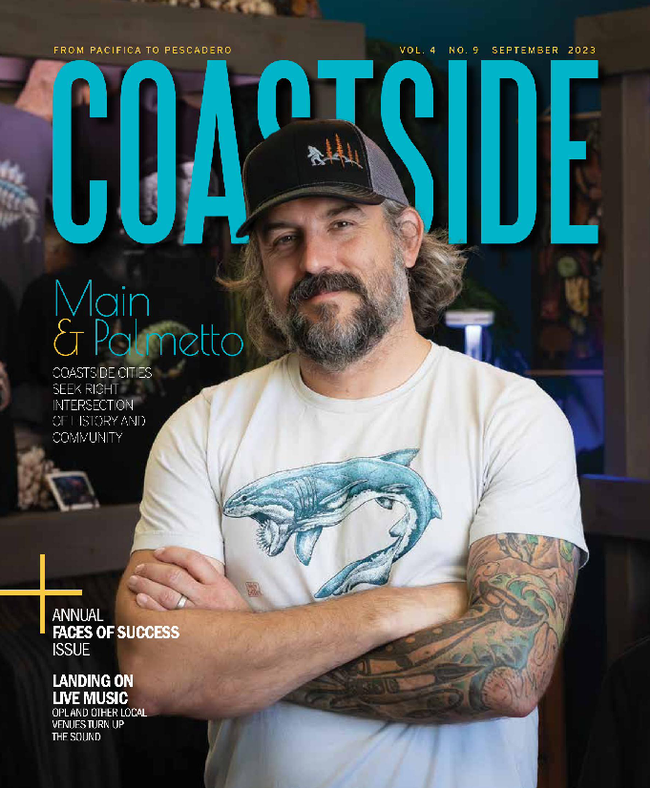Last winter's storms were unprecedented. The volume and intensity of rainfall turned creeks and streams into rushing torrents that overflowed their banks and flooded nearby areas. Gutters and drains couldn't handle the flow and turned streets into virtual canals. We now know that, with climate change, weather patterns are becoming more extreme and we can expect more of this in the future. How can we prepare for and mitigate these episodes of torrential rainfall? Can it be done sustainably and in ways that are beneficial? The answer is “yes,” and the basic idea is thousands of years old. UC SMSF Master Gardeners teamed up with the Half Moon Bay Public Works staff recently to work on one type of solution. Located in front of the Half Moon Bay Library is something called a “green stormwater infrastructure” (GSI). What is a GSI, what is its history, and how do these techniques help in today's urban settings?
Throughout our history, humans have devised a variety of ways to deal with the problem of too much surface water. In Mesopotamia and ancient Egypt, irrigation canals were built with areas of vegetation incorporated into the design. This slowed the water's velocity, allowed it to percolate and prevented the precious, fertile topsoil from being swept away. As time went on, the Romans built aqueducts to direct water flow and constructed roads with permeable surfaces that allowed rainfall to be absorbed.
In the 19th and 20th centuries, the rapid growth of urban areas created more paved surfaces and consequently, fewer permeable areas. Yet another consequence of pavement is that there is less vegetative growth, thereby decreasing evapotranspiration, a process in which plants absorb water through their roots and release it back into the atmosphere. The solution to the problem was to construct vast centralized drainage systems, “gray infrastructure,” to collect both wastewater (sewage) and stormwater to funnel it away from homes, businesses and roadways. Unfortunately, urban stormwater runoff is polluted with trash, bacteria, heavy metals, pesticides and more. In some areas, the water is channeled to treatment plants but in others, it flows directly into rivers, lakes, bays, and oceans. In addition to being a major source of water pollution, these systems are aging and are less able to handle large volumes of water.
In the latter part of the 20th century, due to increased environmental awareness, cities began to explore alternative ways to manage stormwater that included the installation of “green infrastructure systems” as part of the concept of Low Impact Development (LID). Simply put, “green infrastructure systems” utilize plants, soil systems and permeable surfaces to filter and absorb stormwater on site instead of channeling it, along with whatever it picks up along the way, to unknown destinations. LID practices led to improved water quality, the creation of more green spaces in urban settings, and reduction of stormwater flooding.
The San Mateo County-wide Water Pollution Prevention Program was formed in 1990 to reduce the pollution carried by stormwater into local creeks, the San Francisco Bay, and the Pacific Ocean. Flows to Bay is the public outreach arm of this program and endeavors to protect our waterways, the Bay, and the ocean, and to create safer communities and minimize the impacts of heavy storms and climate change. In urban development, GSI is used to balance existing infrastructure and minimize the detrimental effects on the natural system. Impervious surfaces, like roads and parking lots, provide opportunities for managing rainwater.
--Bioswales: strategically located channels or ditches planted with hardy, low maintenance vegetation.
Bioswales are designed to capture stormwater runoff and slow it down. As the water percolates and is taken
up by the plants, sediment and pollutants are filtered out.
--Permeable pavements: firm surfaces that allow water to percolate down instead of sheeting off. Materials
include pervious concrete, porous asphalt and interlocking permeable pavers
--Rain gardens: shallow depressions planted with native vegetation that are designed to collect and absorb
stormwater runoff and act as natural filtration systems that remove pollutants.
--Green roofs: living vegetation on building rooftops that retain rainwater and reduce stormwater runoff. The
insulation improves energy efficiency and promotes biodiversity in urban areas.
--Rainwater harvesting: collecting and storing run-off from rooftops and other impervious surfaces to use for
non-potable applications such as landscape irrigation.
--Tree planting: landscape trees in urban areas help by intercepting rainfall and reducing runoff as well as
filtering pollutants and providing many environmental and social benefits.
--Constructed Wetland Systems: areas designed to mimic natural wetlands for the removal of pollutants and
to improve water quality through biological and physical processes. These areas also provide habitat for
wildlife.
-Parks and green spaces: integrating these areas into urban landscapes allows for increased infiltration of
stormwater provides recreational areas for the community and reduces the impact of urban heat islands.
Green stormwater infrastructures are located throughout San Mateo, and there is a comprehensive Green Infrastructure plan to guide the siting, implementation, tracking, and reporting of GI projects over the next several decades. Currently, a trained cohort of UC Master Gardeners collect data at two GSI (Bioswales) coastside locations. One is in front of the Half Moon Bay library located at 620 Correas Street, HMB, CA 94019 and one is located in Pacifica in front of Cabrillo Middle School at 601 Crespi Drive, Pacifica, CA 94044. UC Master Gardeners record and measure plant vigor and growth, soil conditions, and specific functional elements in these two bioswales while the HMB Public Works staff maintains the bioswales. More information on GSI is found in the resources below.
Resources:
--Bioswale Education and Stewardship Training (BEaST): https://smsf-mastergardeners.ucanr.edu/projects/bioswale-education-stewardship-training/
--City of San Mateo Green Infrastructure Plan: https://www.cityofsanmateo.org/4134/Green-Infrastructure
--Flows to Bay: https://www.flowstobay.org/preventing-stormwater-pollution/in-my-community/green-infrastructure/
--Flows to Bay Studies and Research Link: https://www.flowstobay.org/data-resources/reports/studies-research/
Cynthia Nations is a UC Master Gardener interested in all aspects of Green Stormwater Infrastructures. The article was edited by UC Master Gardener Maggie Mah.
For more news and information about UC SM-SF Master Gardeners visit our website: https://ucanr.edu/sites/MGsSMSF/
